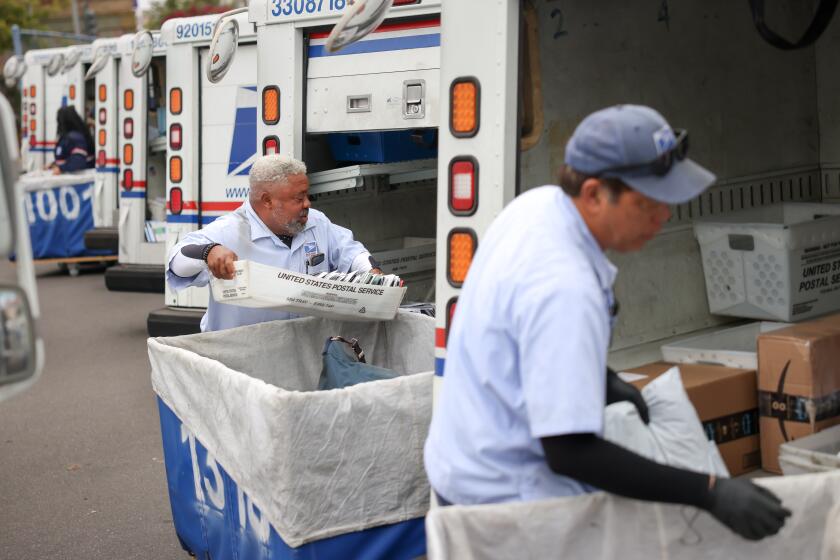ORANGE COUNTY VOICES : An All-Points Bulletin: Coast Must Be Cleared : We simply must track down the sources of urban pollution fouling our beaches and act to minimize its impact.
- Share via
The recent closure of a portion of Huntington Beach highlights the importance of coastal water quality for Southern California’s economy, quality of life, and self-image. As the plume of bacterial pollution waxes and wanes, and frustration over the complexity and intractability of the problem mounts, it is time to consider the causes of coastal pollution and how we can minimize its impact.
Urban pollution enters coastal waters from either point or non-point sources. As the name suggests, point source pollution originates from a single location. A classic example of point source pollution is an ocean outfall, which is a large pipe through which effluent from sewage treatment plants is discharged to the sea. Orange County Sanitation District has one of the largest outfalls in Southern California, extending four to five miles offshore of Huntington Beach.
The outfall’s proximity to the area of beach closure has raised concern that a leak from the pipe, or perhaps strong onshore currents, might be responsible for the bacterial contamination along the shore. While this remains a possibility, point source pollution is generally less of a problem these days because of tough federal and state laws that mandate source control measures, better engineering of treatment facilities, and careful design of discharge structures. Environmental laws, together with good enforcement, have led to a steady decline in the level of contaminants discharged from point sources to our coastal environment.
Future improvements in coastal water quality will require that we tackle a much larger problem: non-point source pollution. Non-point source pollution originates from so many locations that a single point of origin cannot be identified. Therefore it is much more difficult to control.
One type of non-point source pollution that frequently causes contamination and beach closures is urban runoff, the water that flows from our streets into storm drains and ultimately to the ocean without the benefit of treatment. When it isn’t raining, urban runoff begins innocuously by people watering a lawn or washing a car or hosing off a driveway. As the water flows toward the storm drain system, it picks up trash, chemical contaminants from yards, petroleum products from cars and infectious bacteria, viruses and protozoa from animal waste. In Huntington Beach, and many coastal cities, the runoff drains through a series of pipes into large underground storage tanks, and from there is pumped into flood control channels that drain to the beach. Indeed, efforts to find the source of contamination in Huntington Beach are now focusing on urban runoff in the flood control channels that drain into Talbert Marsh.
A recent study published in the journal Epidemiology documents that exposure to untreated urban runoff increases the risk of contracting a broad spectrum of upper respiratory and gastrointestinal diseases. Urban runoff is usually warmer than ocean water, so children often prefer to play at locations on the beach where runoff meets the ocean. This places children directly in harm’s way.
What can we do to prevent this health hazard? Non-point source pollution is a product of Southern California society and a reflection of our habits, laws, institutions and infrastructure. To find viable solutions we must envision new approaches that require cooperation between all levels of government and a renewed sense of individual responsibility and stewardship for the environment.
Because many contaminants originate in our backyards, we must view our immediate environment as a conduit to the sea. Efforts as mundane as disposing of trash, picking up after our dogs or reducing the amount of pesticides and herbicides we use will have a significant cumulative effect.
Officials must see beyond the traditional boundaries of fiscal and legal responsibility to develop new cooperative arrangements. Institutional barriers to pollution prevention are created, for example, when different components of the infrastructure through which urban runoff flows are owned and operated by agencies with divergent views on how to manage the overall system. Recent efforts by the Southern California Coastal Water Research Project to promote an inter-agency and inter-county approach should be applauded and expanded.
Finally, the public should demand that private and government agencies that generate coastal pollution actively promote and fund research into the causes of non-point source pollution and into strategies for reducing its impact.
The bacterial pollution in Huntington Beach is not an isolated event. Non-point source pollution is everybody’s concern, and solving it will require changing how we live in and manage our urban landscape. To ignore the dangers posed by non-point source pollution is to risk losing one of our most important environmental resources, and the economic vitality and quality of life that it sustains.
More to Read
Sign up for Essential California
The most important California stories and recommendations in your inbox every morning.
You may occasionally receive promotional content from the Los Angeles Times.










